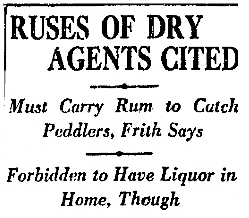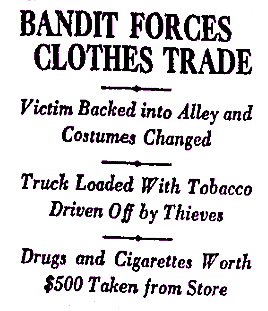Gentle reader, 1947project has moved… to Bunker Hill. For the next twelve months, our dogged blog team will be exploring this lost neighborhood in all its permutations. Yes, we’ll be reporting on the crimes upon the hill, but we’ll also look at architecture, social life, notable residents, transportation, redevelopment, its mysteries and what small survivors remain from the glory days. With this project, we intend to shine a light on a community that was displaced by a well intentioned but misguided slum clearance plan that tore the heart out of L.A.’s downtown, a blow the city still staggers from. As downtown struggles to be reborn as a city center, we need a history more than ever before. Visit On Bunker Hill this year and share in our discoveries, or join us and contribute your own.
Category: downtown
In the Line of Duty
March 16, 1927
Los Angeles
 If the drys are gonna catch the wets, they’re gonna have to wet themselves. So to speak.
If the drys are gonna catch the wets, they’re gonna have to wet themselves. So to speak.
At the trial of John H. Wyncoop, former chief field agent for the boys of the California/Arizona Federal Prohibition Enforcement Department, Wyncoop said “I knew that if I had liquor in my possession I could more easily get bootleggers to believe that I was handling booze and therefore make it easier to arrest bootleggers.â€
Uh-huh.
Wyncoop is on trial because he turned twenty-nine bottles of liquor to his own use, instead of turning it into the government warehouse. Can’t those government know-nothings see that you need that hooch to go under deep cover? That he only took home that demon rum in the solemn performance of his duty?
(Convicted by a jury of illegal conversion, he was given a short term in the county jail.)
Grossery Shopping
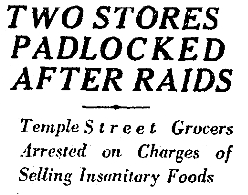
March 15, 1927
Los Angeles
Traditionally, the term greengrocer refers to a retail tradesperson who sells fresh fruits and vegetables. Should you be down on Temple Street, you might find grocer Edith Green to be a greengrocer of the green meat variety. Mmmm. Heck, even her Temple Street neighbor Abraham Margolis purveys criminally suspect comestibles.
Edith, at 922 Temple, and Abraham, at 937, were both charged with selling adulterated and contaminated foodstuffs. Stock amounting to $2,500 ($29,055 currentUSD) were ordered destroyed, she given thirty and he 180 days in the hoosegow, suspended on the condition that they clean up their act. And their stores.
As much fun as it would be to venture in to those structures now to see what eighty year-old smells lingered from the putrid pigs feet and bad borscht, we’ll have to content ourselves with visualizing such while whizzing under the one-ten:
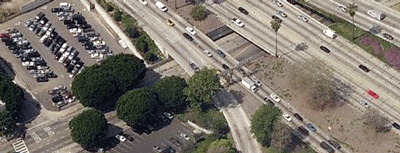
Modes of Banditry, 1927
Los Angeles
Drivers in lonely climes like Topanga Canyon have recently been distressed when stopping to check on a "possum bandit" found napping in the middle of the road. Of course when the do-gooder leans over the prone figure, he leaps up with a gun, steals their valuables, and races off much faster than any marsupial.
Meanwhile, at 317 1/2 South Berendo, two dandified thieves of an agonizing refinement relieved Albert Zigman of $125 cash and $700 in jewels in his own apartment. The victim described one man as having kept his hands in his pockets while gazing at a picture on the wall, as the other flicked cigarette ashes from his lazy perch on the davenport. Shortly afterwards, they relieved neighbor Michael Kreel of his extraneous possessions before slipping off into the night with a yawn and a whip of their cashmere scarves.
We’re Saved!
February 16, 1927
Los Angeles
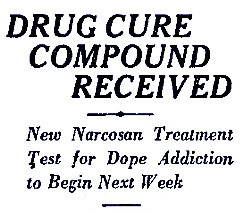 Those junkies and hopheads that once provided the occasional bruise on this perfect ripe plum that is Los Angeles—shall be no more! Though alcoholism was cured in 1908, drug addiction still remains to blight the landscape. But Narcosan has arrived to save the day!
Those junkies and hopheads that once provided the occasional bruise on this perfect ripe plum that is Los Angeles—shall be no more! Though alcoholism was cured in 1908, drug addiction still remains to blight the landscape. But Narcosan has arrived to save the day!
Drs. E. H. Anthony and Benjamin Blank, their committee of peace officers and other physicians in tow, have at their disposal the first shipment from New York of this new European wonder drug.
Any addicted Angeleno can trot down to Blank’s offices in the Quinby Building, Seventh and Grand, and take the cure free of charge. They’ve got fifteen addicts lined up to undergo treatment and are looking to administer to at least another ten, so get down there you, you narc-addled fiend!
(Despite liberal Narcosan administration to the lucky souls who so evidently deserved it, apparently the wonder drug didn’t work out so well.)
Stone Cold

February 11, 1927
Los Angeles
Valentine’s Day is coming up and most couples will celebrate their love with cutesy cards, candy, and maybe some pre-prohibition champagne.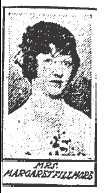 Mr. and Mrs. Hugh Fillmore will not be among the celebrants. Margaret Fillmore has filed for a divorce. Their love has turned as cold as a stone floor.
Mr. and Mrs. Hugh Fillmore will not be among the celebrants. Margaret Fillmore has filed for a divorce. Their love has turned as cold as a stone floor.
Margaret had said that she was annoyed by Hugh’s refusal to give her money, and by his arrogant attitude. But she may have been willing to overlook everything if it hadn’t been for the stone tile.
In her divorce papers Margaret claimed that Hugh had bankrupted her by insisting that she use tile, manufactured by his company, in the home they were building (and she was financing). Margaret claimed that all of her money had gone into the construction of the house, and that the additional $2000 [$24,142.07 current USD] that it cost for the custom tile had left her destitute.
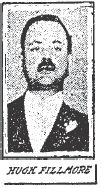 Hugh was thinking only of the advertising potential of having the tile in his home, especially since his sister-in-law was the actress Mary Miles Minter. Perhaps Mary would bring some of her Hollywood cronies over to see the tile. She still had lots of friends in town, even though she had featured prominently in the 1922 mysterious, and still unsolved, slaying of director William Desmond Taylor.
Hugh was thinking only of the advertising potential of having the tile in his home, especially since his sister-in-law was the actress Mary Miles Minter. Perhaps Mary would bring some of her Hollywood cronies over to see the tile. She still had lots of friends in town, even though she had featured prominently in the 1922 mysterious, and still unsolved, slaying of director William Desmond Taylor.
Margaret is having none of it – she’s determined to end her marriage. All she wants now is a divorce and an inexpensive carpet. Sadly, the road to true love is often a rocky (or stony) one.
The Great Stock ‘n’ Roll Swindle
February 9, 1927
Los Angeles
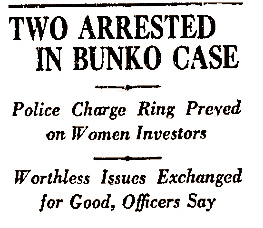 It’s a pretty simple scheme.
It’s a pretty simple scheme.
You own some stock. I approach and inform you that your stock is about to hit bottom. I suggest a trade—your stock for some of mine. The stock I’m offering you is about to go up, up, up, ya see. (Honestly, that’s the long and short of my plan; we swap my stock worth a penny for your stock worth a dollar—your greed does all the heavy lifting.)
When Mrs. Frances L. Derby of 502 North Ardmore was approached by some very nice men, she parted with 102 shares of John C. Frey & Assoc. worth $1,020, and 124 shares of California Guarantee Assoc. worth $498, and in exchange was given 4,700 shares of Silas Frank Mining. The Very Nice Men “talked down” her crummy old stock and represented the mining company stock as being worth $1 a share—when in fact it was worth 1 cent a share, or $47. Mrs. Derby was no ordinary rube, though, got wise, and alerted the authorities.
The aforementioned pleasant fellows being Leon F. Wessling, 36, and J. L. Johannes, 38. Detective Lieutenants Davis and Edwards of bunko detail say these two have, from their brokerage firm—a prestigious suite of offices in the Merritt Building—similarly swindled Los Angeles residents out of $75,000 in the past week.
According to Wessling and Johannes’ records, the duo finagled $18,000 out of one poor old widow alone.
Sad, true, but at least in a few years there’ll be a lot less stock to swindle.
Angels My Eye
 February 3, 1927
February 3, 1927
Seemingly Everywhere
It was another olla podrida fulla banditry in Los Angeles, which bubbled over and burned something fierce at El Molino and Ninth when a gent approached Frank Merlo, robbed him of $50 ($551 USD2006) cash and forced him to swap clothing.
Elsewhere, a truck containing $4,000 worth of cigars and tobacco, parked in front of the Glaser Brother’s establishment at 1028 Wall Street, just up and disappeared; a burglar capable of squeezing through a window not more than seven inches wide entered the Wrede Drug Company at 1327 Fairfax and made off with $200; persons unknown jimmied a rear door of Brunswig Drug at 4922 Santa Monica and btained $500 worth of cigarettes and delicious narcotics.
In residential news, Mrs. Elba Burdick was lightened of $1,000 worth of clothing, rugs and pesky jewelry that were cluttering up her place at 232 Carmelina Avenue; Nathan Lack now lacks one $600 diamond stickpin, formerly in residence at 831 South Harvard; Torato Nishlo was relieved of $500 in jewelry from 925 Hemlock; Dr. H. C. Hill of 806 Golden, also relieved of $500 in jewelry; Nathan Berger, of 2010 Brooklyn Avenue, also relieved of $500 in jewelry; and loot valued at less than $300 was pilfered from a dozen other residences, according to police reports.
Daylight is a good time to work as well—Sam Stone got his register rifled while looking the other way, Stone Furniture Company, 2711 Brooklyn Avenue.
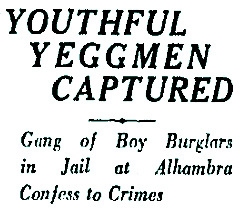 But fret not people of Los Angeles! The bulls have pinched (another) gang of li’luns, ages 15 to 18, who now make the Alhambra pokey their new clubhouse. Their leader was busting into the home of an F. R. Lee on North Wilson when popped, and quickly gave up his younger cohorts—they of reputable local families—and location of purloined rugs, cameras, revolvers, and the black masks (cute—last year) they wore during their heists. The youth of these masked marauders may account for the ability to slip through Wrede Drug’s tiny window. Unless it was those fabled fascistic interwar little people.
But fret not people of Los Angeles! The bulls have pinched (another) gang of li’luns, ages 15 to 18, who now make the Alhambra pokey their new clubhouse. Their leader was busting into the home of an F. R. Lee on North Wilson when popped, and quickly gave up his younger cohorts—they of reputable local families—and location of purloined rugs, cameras, revolvers, and the black masks (cute—last year) they wore during their heists. The youth of these masked marauders may account for the ability to slip through Wrede Drug’s tiny window. Unless it was those fabled fascistic interwar little people.
A Second Engagement
January 2, 1927
Los Angeles

The good people of Los Angeles were reminded today of a quieter, simpler time—a time known as "1921". A magical time of Teapot Domes, and Tulsa Tumults, and shotgun blasts to the face. We collectively remembered the sensational trial of Arthur C. Burch and Madalynne Obenchain, dismissed following jury disagreements, regarding the August 6, 1921 Beverly Glen shooting and .12 gauge buckshot that took apart J. Belton Kennedy’s head. (And now, our obligatory Kennedy "Gaelic For Ugly Head" Kennedy evidence: the shots were fired from a clump of bushes [California: growing better grassy knolls since 1850]; the first shot missed; there was a beautiful woman at the scene, and mysterious tramps…anyway.)
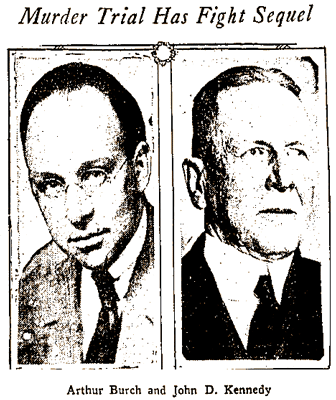 Seems that J. Belton’s father, John D. Kennedy, of 844 South Westlake, never got over the death of his son, or the exoneration of the accused. So today the sixty two year-old is in court on the charge of assault and battery. He headed over to the Terminal Warehouse Building on East 7th where Burch worked in the insurance game. As Burch was innocently hauling some fire extinguishers from one place to another, he suddenly heard “I’ve been waiting a long time but now I’ve got you!” – and was then struck in the face and seized by the throat, but was rescued before he felt the last bit of life choked from him.
Seems that J. Belton’s father, John D. Kennedy, of 844 South Westlake, never got over the death of his son, or the exoneration of the accused. So today the sixty two year-old is in court on the charge of assault and battery. He headed over to the Terminal Warehouse Building on East 7th where Burch worked in the insurance game. As Burch was innocently hauling some fire extinguishers from one place to another, he suddenly heard “I’ve been waiting a long time but now I’ve got you!” – and was then struck in the face and seized by the throat, but was rescued before he felt the last bit of life choked from him.
Authorities were summoned, and said Kennedy the Elder, later, “The affair occurred when my emotions overcame me. I have no regrets and will gladly account for my actions at the proper time and place. When I went in the building no such idea entered my mind, but when I saw him [Burch] coming down the hall I could not restrain myself.
“This is the fist time I have met him fact to face since his trials for the murder of my boy. At the sight of him I was seized with a frenzy and choked him until he began squealing and they came and separated us.”
“I believe he has some pathetic obsession toward me,” Burch declared.
Mrs. Obenchain, living in seclusion in Los Angeles, declined to comment on the matter.
On February 21, John D. Kennedy changed his plea from not guilty to guilty and Municipal Judge Richardson gave him thirty days, suspended, with the caveat: that if Kennedy saw Burch coming, Kennedy was to “go to the other side of the street.”
That, Kennedy said, he could do.
Cop Killer
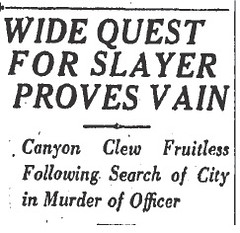
January 28, 1927
Los Angeles
The hunt is on for a cop killer. Traffic Officer Parley Bennett was mortally wounded when he attempted to halt a robbery at Brodin Millinery Company. Bennett was attempting to pull out his revolver when he was shot by the bandit. His weapon discharged as he fell, but fortunately no one was injured by the stray slug. Officer Bennett was dead before he hit the floor.
Services for the slain officer would be held at the Brown Brothers Las Flores Chapel, 935 West Washington Street, and he would be interred at Evergreen Cemetery.
Parley’s widow, Elizabeth, received $1,000 [$12,071.03 USD 2007] worth of police insurance, and merchants on Los Angeles Street (where Bennett died) passed the hat and collected a total of $1,071 for the bereaved woman.
While the fallen officer was being mourned, more that 150 policemen searched in vain for his slayer. Chief of Detectives Cline stated that the search for Parley’s killer would continue indefinitely.
Although 250 suspects would be taken in for questioning, none of them would be positively identified by witnesses to the shooting. There would be the usual sightings of men answering the description of the desperado, but each suspect would ultimately be released. Eventually the leads would dry up, and Officer Bennett’s murder would remain unsolved.


